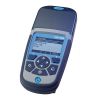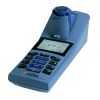YSI 9800 Photometer
Features
- Waterproof IP-67 rating even when using a USB connection to power the instrument
- Large, full-color touchscreen display works even with wet or gloved hands
- Choose from 100+ tests or define your own
- Free ground shipping
- Expedited repair and warranty service
- Lifetime technical support
- More
The YSI 9800 is a portable, multiparameter photometer for quickly and accurately measuring over 30 water quality parameters. For use in the field or lab and featuring a large touchscreen display and an intuitive user interface with onscreen instructions, the 9800 Photometer is the ideal instrument for users of any level of experience operating in any environment!
Rugged and Modern
Waterproof IP-67 rating even when using a USB connection to power the instrument
Impact tested
Abrasion-resistant and chemical-resistant coating
Large, full-color touchscreen display works even with wet or gloved hands
Onscreen step-by-step test instructions
Comfrotable, ergonomic design
Smart, Versatile
Choose from 100+ tests or define your own
Multiple languages, including English, French, Spanish, and Mandarin
User-selectable options for test units, sample numbers, and dilution factors
Automatically stores all test results, data IDs, and user information for data compliance and traceability
Simple Data Management via USB connectivity also powers the instrument
User-upgradeable software via USB connection to PC
1,000 Data Set Memory
Sustainable
Fully serviceable and repairable over the life of the instrument
Carrying case composed of 100% recycled materials
Longer-lasting battery life (up to 5,000 tests per set)
| Instrument Type | Multiparameter Photometer |
| Wavelengths | 430 nm, 465 nm, 530 nm, 575 nm, 620 nm |
| Accuracy | ± 1%T (transmission) |
| Display | Large, Color LCD |
| User Interface | Touch screen with walkthrough text instructions |
| Dimensions |
Width: 211 mm (8.3 in)
Length: 195 mm (7.7 in)
Height: 52 mm (2.0 in)
|
| Weight | 0.85 kg (1.87 lbs) |
| IP Rating | IP-67 |
| Power Supply | 6x AA Batteries or through USB |
| Connectivity | Connect to PC via USB cable |
| Memory Capacity | 1,000 data sets |
| Battery Life | 5,000 tests on one set of batteries |
| Languages | English, French, Spanish, and Chinese (Simplified) |
| Certifications | EN61326, EN61010, IP67, and EN60068-2-78 |
- (1) 9800 Photometer
- (1) Dilution tube
- (1) Syringe (luer slip, 10mL)
- (1) Polishing cloth
- (1) Absorbent cloth
- (1) Test tube brush
- (10) Test tubes
- (10) Stir rods
- (1) USB Type A to C cable
- (1) Reagent box
- (1) Carrying case
- (1) Quick Start Guide
In The News
Three Decades of Research at Acton Lake
A multi-disciplinary team at Miami University, Ohio, has been studying the environmental change at Acton Lake for over three decades. Using three different NexSens buoys over this time, the team has an incredible archive of data that is helping build a picture of Acton’s past, present, and future. Until recently, a NexSens CB-50 buoy was used alongside other environmental monitoring at Acton Lake. In May 2025, the Miami team deployed a new XB-200 buoy , future-proofing their ongoing monitoring using real-time buoy systems. Acton Lake, a small hypereutrophic reservoir in southwest Ohio, covers 2.4km² and has a maximum depth of about 8m. The dam was built in 1956, and the lake has a large agricultural watershed.
Read MoreSource Water Monitoring in Albany, New York: Tracing Water Quality throughout Tributaries
Thousands of US cities pull their drinking water from natural source waters like reservoirs, rivers, and streams, making overall watershed health a key consideration for water providers. In Albany, New York, the Albany Department of Water and Water Supply delivers drinking water to over 100,000 residents as well as monitors and manages the larger drinking water supply watershed. Hannah Doherty, Environmental Specialist at the Albany Department of Water and Water Supply , spends her days working with a small team to monitor the drinking supply and the connected water bodies. Doherty explains, “We’re the first to encounter the water that ends up being the drinking water.
Read MoreWildfire Prevention in the Sierra Nevada Region with the Yuba Watershed Institute
Though recent wildfires have sparked new conversations about wildfire management and response, groups like the Yuba Watershed Institute have been monitoring the forests and water resources of the Sierra Nevada region for decades, managing approximately 5,000 acres of land with the Bureau of Land Management (BLM) and about 7,000 acres in private land partnerships. The goal of the Institute is to work with local communities and land agencies to improve watershed and forestry management through informed practices and public outreach. The goals of the Yuba Watershed Institute are three-fold: Improve the ability of fire suppression agencies like the California Department of Forestry and Fire Protection ( CAL FIRE ) and the US Forest Service.
Read More































































